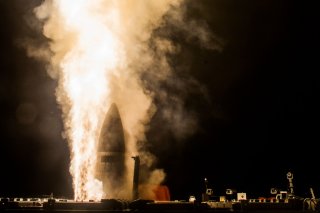The Navy’s SM-3IIA Missile Is Bigger and Badder Than Ever
This missile can shoot down nuclear ICBMs and features several major advancements.
Here's What You Need to Remember: The Missile Defense Agencies’ 2016 “Budget Item Justification” further specifies SM-3 IIA technological advancements, which include more than “doubled seeker capacity” and “more than tripled divert capability.”
History was made on November 16 when a U.S. Navy destroyer eliminated an intercontinental ballistic missile (ICBM) target for the very first time, a development which may well usher in a new era in integrated missile defense. Using an Aegis Ballistic Missile Defense System, the destroyer knocked an ICBM-type target out of the sky over the Pacific Ocean Northeast of Hawaii.
The successful test used an upgraded SM-3 IIA, which is a larger, more precise high-tech SM-3 variant when compared to previous SM-3 variants.
SM-3 missiles, first deployed on Navy ships and now land-fired as well, are exo-atmospheric interceptor missiles designed to destroy short and intermediate range incoming enemy ballistic missiles as they approach the boundaries of the earth’s atmosphere while traveling from space. While they have for many years been proven effective against short, medium and long-range ballistic missiles, the SM-3IIA has now shown an ability to destroy ICBMs traveling through space.
“We have demonstrated that an Aegis BMD-equipped vessel equipped with the SM-3 Block IIA missile can defeat an ICBM-class target, which is a step in the process of determining its feasibility as part of an architecture for layered defense of the homeland,” Missile Defense Agency Director, Vice Admiral Jon Hill said in a statement.
The SM-3 is a kinetic energy warhead able to travel more than 600 miles per hour; it carries no explosive but instead relies on the sheer force of impact and collision to destroy an enemy target. As Pentagon developers describe it, an SM-3 Block IIA missile is a larger version of the SM-3 IB in terms of boosters and the kinetic warhead, allowing for longer flight times and engagements of threats higher in the exo-atmosphere. Some of the improvements engineered into the SM-3 IIA missile are described as “sensitivity increases” which use a larger focal plane array for detection and more computer processing power. An improved seeker can better see approaching targets from longer distances compared to the SM-3 1B.
“This first-of-its-kind test shows that our nation has a viable option for a new layer of defense against long-range threats,” Bryan Rosselli, vice president of Strategic Missile Defense at Raytheon Missiles & Defense, said in a written statement.
Rosselli’s comment about a new layer of defense seems significant, given that an ICBM-killing SM-3IIA may be able to hit ICBMs in locations or at times where a larger Ground Based Interceptor could not perform an intercept. The mid-course phase of when an enemy ICBM travels, the portion of its flight where it is traveling through space, affords the most opportunities for intercept as it is by far the longest period of time or “window” in which to destroy the enemy target.
The Missile Defense Agencies’ 2016 “Budget Item Justification” further specifies SM-3 IIA technological advancements, which include more than “doubled seeker capacity” and “more than tripled divert capability.” The budget documents add that the new SM-3 IIA technologies include “lightweight nose cone, advanced kinetic warhead” and a 21-inch second and third stage rocket motors. Aerojet Rocketdyne’s MK 72 booster and MK 104 dual-thrust rocket motor provides the first and second stage propulsion.
Kris Osborn is the Defense Editor for the National Interest. Osborn previously served at the Pentagon as a Highly Qualified Expert with the Office of the Assistant Secretary of the Army—Acquisition, Logistics & Technology. Osborn has also worked as an anchor and on-air military specialist at national TV networks. He has appeared as a guest military expert on Fox News, MSNBC, The Military Channel, and The History Channel. He also has a Masters Degree in Comparative Literature from Columbia University.
Image: Flickr.

